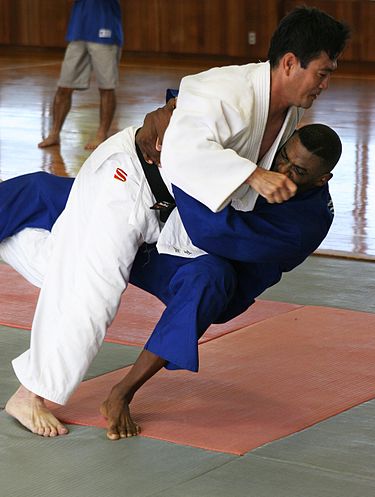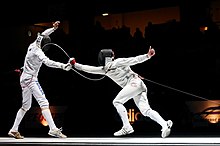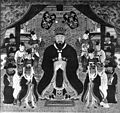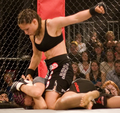Portal:Martial arts
Portal maintenance status: (July 2019)
automated editing software, and seek consensus before making major changes. Learn how to update the maintenance information here . |
The Martial Arts Portal

Although the earliest evidence of
Specific martial
Selected articles
-
Image 1Final of the Challenge Réseau Ferré de France–Trophée Monal 2012, épée world cup tournament in Paris.
Fencing is a combat sport that features sword fighting. The three disciplines of modern fencing are the foil, the épée, and the sabre (also saber); each discipline uses a different kind of blade, which shares the same name, and employs its own rules. Most competitive fencers specialise in one discipline. The modern sport gained prominence near the end of the 19th century and is based on the traditional skill set of swordsmanship. The Italian school altered the historical European martial art of classical fencing, and the French school later refined that system. Scoring points in a fencing competition is done by making contact with an opponent.
The 1904 Olympics Games featured a fourth discipline of fencing known as singlestick, but it was dropped after that year and is not a part of modern fencing. Competitive fencing was one of the first sports to be featured in the Olympics and, along with athletics, cycling, swimming, and gymnastics, has been featured in every modern Olympics. (Full article...) -
Image 2EliteXC events. This was furthered by her appearances on MGM Television's 2008 revival of their game show American Gladiators.)
The UFC's decision to allow female fighters in the organization, to promote the dominant fighter Ronda Rousey, is often cited as the reason women's mixed martial arts became known to the general public. Rousey won the Best Fighter ESPY Award at the 2015 ESPN ESPY awards, beating out noted fighters such as Floyd Mayweather Jr., and becoming the first UFC and MMA fighter to win the award. (Full article...Image 3Chong Chul Rhee, one of the original masters of taekwondo, founded the school in the mid-1960s. Two of Rhee's brothers, Chong Hyup Rhee and Chong Yoon Rhee, later came to assist him in the 1970s.)
C. C. Rhee claims the title 'Father of Australian Taekwondo' and Rhee Taekwon-Do is widely publicised as being Australia's first and biggest taekwondo school. It has at least 294 publicly listed dojang (training halls) in Australia, with perhaps around 1,400 dojang in total at its peak. Several Australian martial art school founders received their foundational taekwondo training in Rhee's school. (Full article...Image 4Muay Lao, Kun Khmer, Lethwei, Benjang and Tomoi. A practitioner of Muay Thai is known as a Nak Muay. Western practitioners in Thailand are sometimes called Nak Muay Farang, meaning "foreign boxer". (Full article...)Image 5full contact combat sport from Myanmar that uses stand-up striking including headbutts. Lethwei is considered to be one of the most brutal martial arts in the world, as the sport is practiced bareknuckle with only tape and gauze while fighters are allowed to strike with their fists, elbows, knees, and feet, and the use of headbutts is also permitted. Disallowed in most combat sports, headbutts are important weapons in a Lethwei fighter's arsenal, giving Lethwei its name of the "Art of nine limbs". This, combined with its bareknuckle nature, gave Lethwei a reputation for being one of the bloodiest and most violent martial arts. Although popular throughout modern Myanmar, Lethwei has been primarily and historically associated with the Karen people of the Kayin State; vast majority of competitive Lethwei fighters are ethnolinguistically of Karen descent. (Full article...)Image 6Full article...)Image 7martial art that combines combat techniques, self-defense, sport, exercise, and meditation. A key component of angampora is the namesake angam, which incorporates hand-to-hand fighting, and illangam, involving the use of indigenous weapons such as the ethunu kaduwa, staves, knives and swords. Another component known as maya angam, which uses spells and incantations for combat, is also said to have existed. Angampora's distinct feature lies in the use of pressure point attacks to inflict pain or permanently paralyze the opponent. Fighters usually make use of both striking and grappling techniques, and fight until the opponent is caught in a submission lock that they cannot escape. Usage of weapons is discretionary. Perimeters of fighting are defined in advance, and in some of the cases is a pit.)
A number of paintings related to angampora are found at Buddhist temples in Sri Lanka. These include Embekka Devalaya, Gadaladeniya Rajamaha Viharaya, Temple of the Tooth, Saman Devalaya (Ratnapura) and Lankathilaka Rajamaha Viharaya. (Full article...Image 8English, and Scottish schools of fencing in the modern period (17th and 18th centuries). (Full article...)Image 9Boxer resting after contest (bronze sculpture, 300–200 BC).
Ancient Greek boxing (Greek: πυγμαχία pygmachia, "fist fighting") dates back to at least the 8th century BC (Homer's Iliad), and was practiced in a variety of social contexts in different Greek city-states. Most extant sources about ancient Greek boxing are fragmentary or legendary, making it difficult to reconstruct the rules, customs and history surrounding this activity in great detail. Still, it is clear that gloved boxing bouts were a significant part of ancient Greek athletic culture throughout the early classical period. (Full article...)Image 10As of 2023, there have been twenty recorded deaths resulting from sanctioned mixed martial arts contests and nine from unregulated bouts, none however in the largest MMA promotion Ultimate Fighting Championship. A 2006 study suggests that the risk of injury in general in MMA is comparable to that in professional boxing. For professional boxing matches, the Manuel Velazquez Boxing Fatality Collection lists 923 deaths during the 118-year period of 1890–2008. (Full article...)Selected biography
Armenian SSR, but left the country with her family at the age of five because of the First Nagorno-Karabakh War. Kentikian has lived in Hamburgsince 1996 and began boxing at the age of twelve.Kentikian is a two-time flyweight world champion, having held the unified World Boxing Association (WBA) and World Boxing Organization (WBO) female titles between 2007 and 2012, and the WBA female title again from 2013 to 2017. Additionally, she held the Women's International Boxing Federation (WIBF) title twice between 2007 and 2017. During the 2009 WBA convention in Colombia she was named the first ever female Super champion. It was announced that this belt would be called "Susi Kentikian belt" for all other future Super champions. (Full article...)
Selected entertainment
Mortal Kombat is an American media franchise centered on a series of fighting video games originally developed by Midway Games in 1992.
The original
action-adventure games, a comic book series, a card game, films, an animated TV series, and a live-action tour. Mortal Kombat has become the best-selling fighting game franchise worldwide and one of the highest-grossing media franchises of all time.The series has a reputation for high levels of graphic violence, including, most notably, its
Warner Bros. Entertainment and re-established as NetherRealm Studios.
Sports portals
Selected image
)

Execution of a judo throw (ōuchi-gari). The player in blue is being thrown. Credit: Lance Cpl. Scott M. Biscuiti
Judo (Japanese: 柔道, Hepburn: Jūdō, lit. 'gentle way') is an unarmed modern Japanese martial art, combat sport, Olympic sport (since 1964), and the most prominent form of jacket wrestling competed internationally. Judo was created in 1882 by Kanō Jigorō (嘉納 治五郎) as an eclectic martial art, distinguishing itself from its predecessors (primarily Tenjin Shinyo-ryu jujutsu and Kitō-ryū jujutsu) due to an emphasis on "randori" (乱取り, lit. 'free sparring') instead of "kata" (pre-arranged forms) alongside its removal of striking and weapon training elements. Judo rose to prominence for its dominance over established jujutsu schools in tournaments hosted by the Tokyo Metropolitan Police Department (警視庁武術大会, Keishicho Bujutsu Taikai), resulting in its adoption as the department's primary martial art. A judo practitioner is called a "judoka" (柔道家, jūdōka, lit. 'judo performer'), and the judo uniform is called "judogi" (柔道着, jūdōgi, lit. 'judo attire'). (Full article...Judo Grand Slam Tokyo.Highest governing body International Judo Federation Characteristics Contact Yes Mixed-sex No Type Martial art Presence Country or region Worldwide Olympic Debuted in 1964
General images - load new batch
The following are images from various martial arts-related articles on Wikipedia.-
Image 1AAncient China. (from Mixed martial arts)
-
Image 2Modern forms are used in the sport of wushu, as seen in this staff routine (from Chinese martial arts)
-
Image 3A scene of ancient Greek pankratiasts fighting. Originally found on a Panathenaic amphora, Lamberg Collection. (from Mixed martial arts)
-
Image 4Groundfighting in MMA. Differently from other grappling-based martial arts, you are allowed to strike your opponent when fighting on the ground. (from Mixed martial arts)
-
Image 5MMA fighter attempts aArmbar submission on his opponent. (from Mixed martial arts)
-
Image 8Bruce Lee popularized the concept of mixed martial arts via his hybrid philosophy of Jeet Kune Do during the late 1960s to early 1970s. (from Mixed martial arts)
-
Image 9Two children training injudo techniques (from Judo)
-
Image 11Depiction of fighting monks demonstrating their skills to visiting dignitaries (early 19th-century mural in the Shaolin Monastery). (from Chinese martial arts)
-
Image 12Martial arts fan (from Chinese martial arts)
-
Image 15Gichin Funakoshi (from Karate)
-
Image 16Dragon Ball's main protagonist Goku uses a variety and hybrid of east Asian martial arts styles, including Karate. (from Karate)
-
Image 17Japanese judoka Takamasa Anai Vs French judoka Thierry Fabre during the 2010 World Judo Championships held in Tokyo (from Judo)
-
Image 18Judo (1935) (from Judo)
-
Image 19Thethe Bund in Shanghai (from Chinese martial arts)
-
Image 20Mural at Shaolin temple from 1830's depicting forearm strikes and reverse kicks (from Chinese martial arts)
-
Image 21Eisho-ji temple, Tokyo (from Judo)
-
Image 22Pankratiast in fighting stance, Ancient Greek red-figure amphora, 440 BC. (from History of martial arts)
-
Image 23Olympic Judo pictogram (from Judo)
-
Image 24Two judoka wearing judogi (from Judo)
-
Image 25King Shō Shin (from Karate)
-
Image 28A ring-side doctor attends to a fighter following a loss. (from Mixed martial arts)
-
Image 29Jigoro Kano and Yamashita Yoshitsugu performing Koshiki-no-kata (from Judo)
-
Image 30Bronze medal match at the 2018 Summer Youth Olympics in Buenos Aires, Argentina. (from Karate)
-
Image 31Kung fu in Iran (from Chinese martial arts)
-
Image 32MMA gloves. They are fingerless gloves which allow both striking and grappling to occur. (from Mixed martial arts)
-
Image 33An octagon cage used by the UFC. (from Mixed martial arts)
-
Image 34Ancient Chinese weapons (from Chinese martial arts)
-
Image 35Yoshihiko Yoshimatsu attempting to throw Toshiro Daigo with an uchi mata in the final of the 1951 All-Japan Judo Championships (from Judo)
-
Image 36A "Unified Rules of Mixed Martial Arts (from Mixed martial arts)
-
Image 40Karatekas wearing different colored belts (from Karate)
-
Image 41Two Brazilian fighters in aSport Wushu (from Chinese martial arts)
-
Image 42The judogi is made from a heavy weave to withstand the stress of throwing and grappling. (from Judo)
-
Image 45Yuki Nakai fights UFC 1 finalist Gerard Gordeau at Vale Tudo Japan 1995 (from Mixed martial arts)
-
Image 46Jigoro Kano, founder of judo (from Judo)
-
Image 47Throw during competition, leads to an ippon (from Judo)
-
Image 50Kung fu sword (from Chinese martial arts)
-
Image 51pancratium, an event which took place in the Roman Colosseum. Even as late as the Early Middle Ages, statues were put up in Rome and other cities to honor remarkable pankratiasts. This statue, now part of the Uffizi collection, is a Roman copy of a lost Greek original, circa 3rd century BC. (from Mixed martial arts)
-
Image 53Vale tudo match betweenthai boxer Flávio Molina and Brazilian jiu-jitsu practitioner Marcelo Behring, 1984 (from Mixed martial arts)
-
Image 56Fol. 4v of the I.33 (from History of martial arts)
Selected quote
Most sports require you to master the movements of only your own body to be successful. The combat jujitsu, require you to become the master not only of your own movement but also that of your opponent—a far more difficult and complex task., Mastering Jujitsu
Topics
- Weapons - Archery - Duel - Knife fighting - Melee weapons - Shooting - Stick-fighting - Swordsmanship
- Training - Kata - Practice weapon - Punching bag - Pushing hands - Randori - Sparring
- Xing Yi Quan
- Entertainment - Fighting game - Martial arts film (Chanbara) - Professional wrestling - Stage combat - Wuxia
ClassificationRegional origin Unarmed
techniquesWeapons Training Grappling Striking Internal Full contact /
combat sportsSelf-defense /
combativesEclectic / hybrids Battlefield Entertainment International gamesMartial arts at the
Summer OlympicsMartial arts at the
World GamesMartial arts at the
Pan American GamesMartial arts at the
Asian GamesMartial arts at the
African GamesMartial arts at the
European GamesCategories
Things you can do
See the list on the right of Martial art related projects who organise work on these articles. You can also add your self to the list of Wikipedians by martial art
Talk page tagging
If you come across a martial arts related article, adding the project template {{WikiProject Martial arts}} to the talk page will help identify them for improvement and linking to related articles. For Boxing, Fencing, Mixed martial arts and Sumo. Use {{WikiProject Boxing}}, {{WikiProject Fencing}}, {{WikiProject Mixed martial arts}} and {{WikiProject Sumo}} respectively.
- Assessment
- If possible please assess articles you tag using ).
Deletions
Monitor and contribute to deletion debates (Boxing).
Find images
Wikipedia requested images of martial artists, mixed martial artists and boxers.
WikiProjects
Associated Wikimedia
The following Wikimedia Foundation sister projects provide more on this subject:
-
Commons
Free media repository -
Wikibooks
Free textbooks and manuals -
Wikidata
Free knowledge base -
Wikinews
Free-content news -
Wikiquote
Collection of quotations -
Wikisource
Free-content library -
Wikiversity
Free learning tools -
Wikivoyage
Free travel guide -
Wiktionary
Dictionary and thesaurus
Discover Wikipedia using portals


















































































